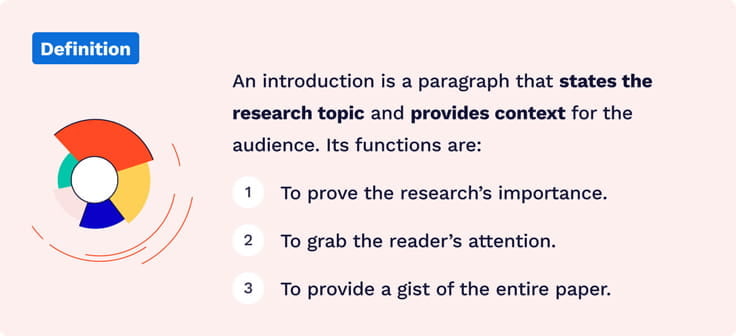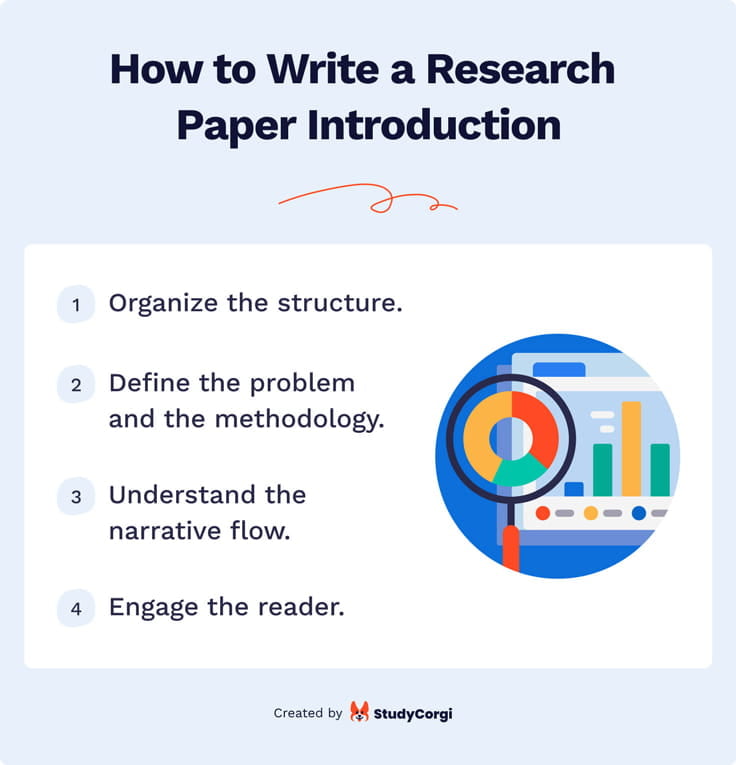🚀 Why Choose Our Research Introduction Maker?
If you’re wondering whether you should use our tool, here’s a list of benefits that will show you why our app is so fantastic:
| 🆓️ It's free | You don’t have to pay anything to access its features. |
|---|---|
| 🤝 It’s easy to use | Check out our app’s friendly interface! |
| 🤩 It’s super effective | All you need to do is fill in the necessary parameters and click a single button. Your research introduction will be ready in a flash. |
| 🚀 It's speedy | There’s no need to spend hours working on a perfect introduction. You can generate it right now! |
🔎 What Is a Research Introduction?
An introduction is a paragraph that presents the research topic and provides context for the reader. It has the following functions:
- to convey the significance of your research project;
- to catch the reader's attention;
- to provide a gist showing what the research paper will be about.

💡 Parts of a Research Introduction
What makes a good introduction? To answer this question, we need to discuss the introduction's structure first. It includes a hook, background information, and a problem statement. Let’s examine each part in more detail.
Research Introduction Hook
A hook is an introductory sentence that aims to grab the reader's attention and simultaneously prove the significance of an entire research project.
People are particularly attentive when reading a paper's beginning and end. That’s why your hook must draw as much interest as possible.
There are a few different hook types that you can use. Which one suits your needs best?
- A question hook starts with a strong question addressed to your reader.
- A citation hook presents a quotation that is connected to the research topic.
- A statistics hook provides shocking or striking statistics that indicate the importance of the research.
Background Description
Background information provides everything your audience needs to know before reading your research. It should describe the nature of the topic, its depth, and other notable aspects. It should also mention how much earlier studies have looked into the issue, highlighting literature gaps that your research project aims to fill.
Background description can vary depending on the research’s topic. Consider the following types:
| Background type | With what topics to use it |
|---|---|
| ⏰ Temporal | Issues that are limited in time. |
| 📏 Spatial | The area surrounding something. |
| 👥 Social | Communication between people. |
| 🏺 Cultural | The behavior of particular groups. |
| 📜 Philosophical | Philosophical notions and phenomena. |
| 🗳 Political | Governmental institutions, politicians, or political relations. |
| 💸 Economical | Business, management, finance, or any trade relationship. |
| 🏦 Historical | Something that happened long ago but is still influencing the modern world. |
Research Problem
A research problem statement identifies the main issue that your research is trying to resolve. It should be written in a style that’s easy to grasp for specialists and laypersons.
A powerful explanation of the research problem must be concise, easy to understand, and, most importantly, relevant. To formulate it, answer the following questions:
- Why are you concerned about this topic?
- What will happen to the society if this issue is resolved?
- What are you planning to do to succeed in resolving that problem?
A good research problem statement should have the following components:
| ✅ The problem's importance | This component aims to actualize the problem. It also provides supporting information that will close the potential gaps in the reader's understanding of the topic. |
|---|---|
| ✅ The research's scope | The research problem statement describes the particular environment or context the study will focus on. |
| ✅ The theoretical framework | This component explains theoretical ideas and principles related to the research’s topic. |
| ✅ The research design | The design gives a brief description of the methods that will be used in the research. |
Research Objectives
Research objectives are the results you want to obtain from your study. Strong research objectives create a roadmap for the entire project. This roadmap can be very convenient, as it will direct further research, including data collecting methods, analysis, and even conclusions. This way, you will know which parts of your study require more attention than others.
The steps to writing a research objective are as follows:
- Locate the main focus of your research.
- Separate the smaller goals from the main focus.
- List all the objectives in order of importance.
📚 Argumentative vs. Empirical Papers Introduction
Before you write an introduction for your research, it’s vital to understand which type of research you’re writing: argumentative or empirical. Each type implies a specific introduction.
| 📖 Argumentative style | 🔬 Empirical style |
|---|---|
| Used for humanities and liberal arts | Used for sciences |
|
|
✍️ How to Make an Introduction to Research Paper
Now that you know about all the components of a research paper introduction, it’s time we discuss how to write it. Follow these steps to create a perfect introduction!

1. Organize the Structure
Outline the introduction's potential structure and present the general overview of the research topic. We advise you to focus on your paper’s context before adding the final objectives. After providing context, consider all achievable and reachable goals using the SMART method.
2. Define the Problem and the Method
While researching your topic, it's important to look for under-examined elements or literature gaps. Your main objective at this stage is to find and define a problem statement for your topic. After you've figured it out, think of the methods that can help you resolve your research problem. You can also look through other people’s papers and check their methodologies.
3. Understand the Narrative Flow
After you’ve defined the problem, you need to provide a brief description of your research. This means:
- writing a review of the literature that you’re planning to analyze;
- stating a hypothesis for your topic;
- explaining why you chose this topic in particular.
4. Engage the Reader
Think about how you'll engage your reader in discussing the research problem. Feel free to use any of the hooks described earlier:
- A strong question.
- A piece of statistics.
- An interesting quotation.
You can also include an anecdote from personal experience that will actualize the issue you're observing.
Follow these steps to create a good introduction!
If you don't feel like getting into all that detail and just want to get a great introduction on the spot, we highly recommend you check out our research introduction maker. It can instantly make you an intro that will definitely stand out!
📑 Research Introduction Example
Finally, we would like to give you an example of an excellent empirical introduction for your research paper. Remember that our generator can produce as many examples as you’d like—for free!
| Hook | In the online course Disruptive Strategy, Harvard Business School professor Clayton Christensen notes that in a study of HBS graduates who started a business, 93 percent of those who followed successful strategies "evolved" and deviated from their initial strategic plans. According to Christensen, "Most people think of strategy as an event, but the world works differently." |
|---|---|
| Background | Strategic planning is essential in the conditions of modern market relations because it allows for predicting and identifying the weaknesses and strengths of the company. |
| Research problem | Thus, the relevance of the topic of this research lies in the need to be able to predict, plan and organize the company's operational activities. |
| Research objectives | This research aims to develop a strategic plan for a large company. In order to achieve this goal, it is necessary to set a number of tasks:
|
It’s time to wrap up this article. Now, you’re ready to write a good introduction for your research! Feel free to use our awesome generator—it will make you a perfect intro with one click.
If you want to take your research writing to the next level, try our research question maker.
❓ Research Introduction Maker FAQ
❓ How do you start a research paper introduction?
You should begin your introduction with a hook. The hook is a catchy opening sentence that attracts attention and shows your topic`s relevance. Choose a compelling fact, a piece of statistics, an assertion, a question, or an anecdote that will pique the reader`s interest in your subject.
❓ How long should an introduction be for a research paper?
A proper introduction should be 400 words and 1-4 paragraphs at most. Use it to describe the significance of your research to the reader and to grab their attention.
❓ What should be in a research paper introduction?
A research paper introduction consists of 6 parts:
- Summary of the subject.
- Earlier studies on this topic.
- Actualization of the research problem.
- A description of methods used.
- Literature review.
- A thesis statement.
❓ What to include in a research paper introduction?
Make sure to include the following in your research paper:
- The subject of your research.
- The indication of a particular issue or problem.
- The problem`s importance.
- Research questions, objectives, and scope.
- The theoretical framework.
- The research design.
📍 References
- Introduction Section for Research Papers: San Jose State University
- The Introduction: Organizing Your Social Sciences Research Paper: University of Southern California
- Introductions for Research Papers: The University of Texas at El Paso
- Writing a Scientific Paper: Introduction: University of California Irvine